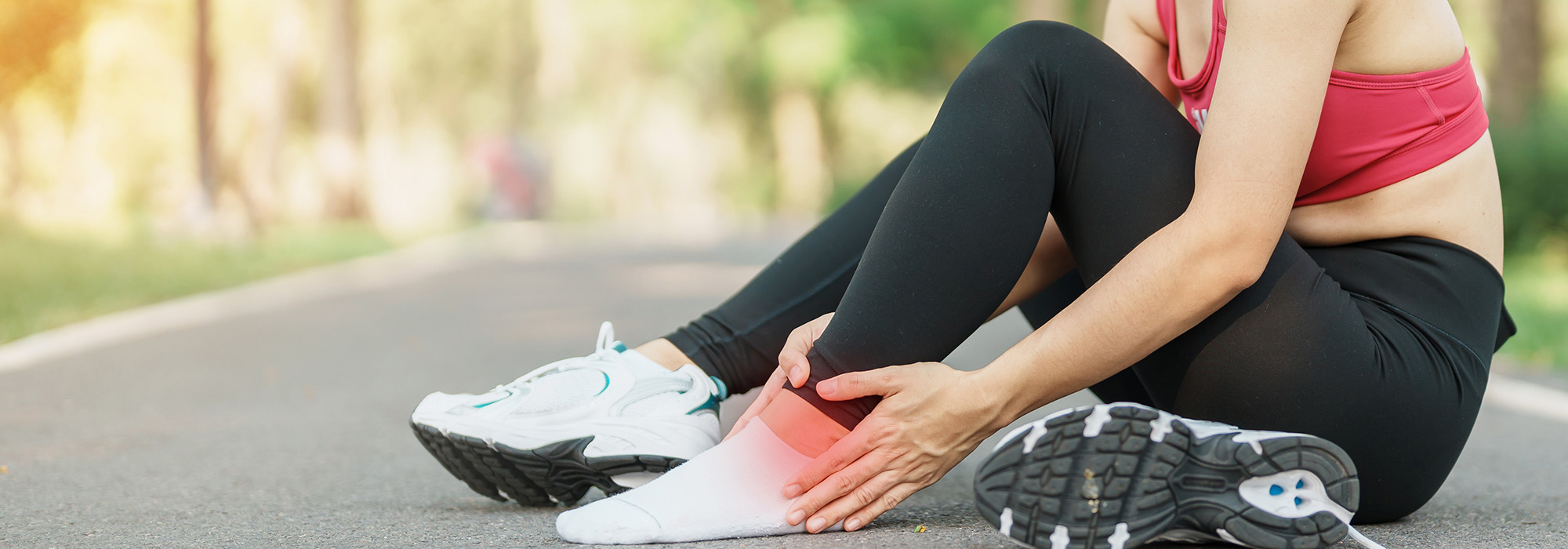

Four Reasons Your Ankle Hurts and How to Fix It
You are most likely reading this because you have ankle and foot pain now, you have had it in the past, or you know someone who does. Efforts to try to cope with ankle pain, from walking boots, to ankle braces, ace wraps, and crutches have been used by many yet it seems that even after that, many of us still deal with it. There is nothing like classic ankle pain that shortens your stride and slows your pace. An estimated 11% of people will have ankle pain at some point in life, but if you are like me, I can appreciate things that limit any unnecessary discomfort. Here are some reasons your ankle might hurt (and how to fix it):
1 You’ve Sprained it
I know what you’re thinking, “Of course it hurts if I’ve sprained my ankle.” Well, this is not just for those who have just recently sprained their ankles. If you sprain your ankle today, you are more likely to treat it with ice and compression and elevation to get rid of the pain. Unfortunately, once the initial pain is gone, we lose that reminder that our ankle isn’t as strong and stable as it was prior to the sprain. This instability, or lack of control and balance at the ankle can lead to increased irritation and even impingement (or pinching) of structures around the joint thus causing the pain (and swelling) to return.
How to Fix It: Start doing single limb stance exercises on the previously affected ankle. For example, try to stand on one leg (once the pain has reduced) and work on balancing on that leg. If this is easy, swing the other leg back and forth at varying speeds to challenge the balance of the stance leg. Exercises like this help build endurance in the smaller muscles that help to
2 Your Shoes are Hurting You
I wouldn’t dare to bring up the issue of wearing high heel shoes to the ladies reading this article. I’m sure you’ve heard stories of how wearing high heels over long periods of time can cause foot and ankle problems from fractures, arthritis, hammer toes, ingrown toenails, and other problems. Instead of bringing that up, let’s address shoes in general. The best thing to keep in mind is that a good shoe should feel good when you wear it. If you are wearing shoes that are too tight, too loose, or don’t have enough support, you just might be setting yourself up for foot and ankle pain.
How to Fix It: Remember, that although once you are an adult, you might stop growing in height but that doesn’t mean your feet are not changing shape. Go to a good shoe store and have your feet measured to see what size you truly need. Perhaps you need a narrow or a wide shoe. Be sure to find that out and get the shoe that fits you best. It’s not the price that makes a shoe good, but rather, the fit that makes it good for you.
3 Your Arch Support is Weak
There is a long tendon that goes under your foot that supports the arch. It comes from a muscle in the back of your leg called the posterior tibialis. When this muscle weakens over time, the dysfunction can cause your foot to flatten more. Over time this can cause pain to move to the outside of your foot and ankle.
How to Fix It: Wearing shoes that support your arch is very important to help lift some of the pressure off of one part of your foot. Exercise to strengthen the posterior tibialis is helpful for long term improvement as well. One of the best exercises is to sit in a chair and resist turning and curling your foot inward using a resistance band while keeping your foot flat on the floor. It helps to strengthen the tibialis muscle that supports the arch.
4 Your Achilles Tendon
The Achilles tendon can become irritated by tight shoes, strained, or overused. If It’s been a while since you’ve ran or played basketball and you decided to jump right back in at 5 miles or 4 pick up basketball games, it’s likely that you know what this is all about. An irritated Achilles tendon can cause cramping at your leg muscles and even pain at your foot and ankle. Plantar fasciitis is a common complaint of pain at the foot and ankle after overuse.
How to Fix It: Progress back into exercises at a slower, reasonable pace if you have not done the activities in a while. Jumping and repeated hopping activities are important to pace. Also, before you take that first step in the morning, stretch your smaller foot muscles by using your hand to stretch all of your toes backwards repeatedly for 20-30 seconds each time. Do this first thing in the morning and you’ll find that first step is not so bad.
These are only a few of the common reasons for ankle pain. Give these solutions a try but whatever you do, if you have pain that doesn’t go away, don’t ignore it. Speak to your physician or your physical therapist right away.
Please Share
categories
Recent Posts
categories

Four Reasons Your Ankle Hurts and How to Fix It
You are most likely reading this because you have ankle and foot pain now, you have had it in the past, or you know someone who does. Efforts to try to cope with ankle pain, from walking boots, to ankle braces, ace wraps, and crutches have been used by many yet it seems that even after that, many of us still deal with it. There is nothing like classic ankle pain that shortens your stride and slows your pace. An estimated 11% of people will have ankle pain at some point in life, but if you are like me, I can appreciate things that limit any unnecessary discomfort. Here are some reasons your ankle might hurt (and how to fix it):
1 You’ve Sprained it
I know what you’re thinking, “Of course it hurts if I’ve sprained my ankle.” Well, this is not just for those who have just recently sprained their ankles. If you sprain your ankle today, you are more likely to treat it with ice and compression and elevation to get rid of the pain. Unfortunately, once the initial pain is gone, we lose that reminder that our ankle isn’t as strong and stable as it was prior to the sprain. This instability, or lack of control and balance at the ankle can lead to increased irritation and even impingement (or pinching) of structures around the joint thus causing the pain (and swelling) to return.
How to Fix It: Start doing single limb stance exercises on the previously affected ankle. For example, try to stand on one leg (once the pain has reduced) and work on balancing on that leg. If this is easy, swing the other leg back and forth at varying speeds to challenge the balance of the stance leg. Exercises like this help build endurance in the smaller muscles that help to
2 Your Shoes are Hurting You
I wouldn’t dare to bring up the issue of wearing high heel shoes to the ladies reading this article. I’m sure you’ve heard stories of how wearing high heels over long periods of time can cause foot and ankle problems from fractures, arthritis, hammer toes, ingrown toenails, and other problems. Instead of bringing that up, let’s address shoes in general. The best thing to keep in mind is that a good shoe should feel good when you wear it. If you are wearing shoes that are too tight, too loose, or don’t have enough support, you just might be setting yourself up for foot and ankle pain.
How to Fix It: Remember, that although once you are an adult, you might stop growing in height but that doesn’t mean your feet are not changing shape. Go to a good shoe store and have your feet measured to see what size you truly need. Perhaps you need a narrow or a wide shoe. Be sure to find that out and get the shoe that fits you best. It’s not the price that makes a shoe good, but rather, the fit that makes it good for you.
3 Your Arch Support is Weak
There is a long tendon that goes under your foot that supports the arch. It comes from a muscle in the back of your leg called the posterior tibialis. When this muscle weakens over time, the dysfunction can cause your foot to flatten more. Over time this can cause pain to move to the outside of your foot and ankle.
How to Fix It: Wearing shoes that support your arch is very important to help lift some of the pressure off of one part of your foot. Exercise to strengthen the posterior tibialis is helpful for long term improvement as well. One of the best exercises is to sit in a chair and resist turning and curling your foot inward using a resistance band while keeping your foot flat on the floor. It helps to strengthen the tibialis muscle that supports the arch.
4 Your Achilles Tendon
The Achilles tendon can become irritated by tight shoes, strained, or overused. If It’s been a while since you’ve ran or played basketball and you decided to jump right back in at 5 miles or 4 pick up basketball games, it’s likely that you know what this is all about. An irritated Achilles tendon can cause cramping at your leg muscles and even pain at your foot and ankle. Plantar fasciitis is a common complaint of pain at the foot and ankle after overuse.
How to Fix It: Progress back into exercises at a slower, reasonable pace if you have not done the activities in a while. Jumping and repeated hopping activities are important to pace. Also, before you take that first step in the morning, stretch your smaller foot muscles by using your hand to stretch all of your toes backwards repeatedly for 20-30 seconds each time. Do this first thing in the morning and you’ll find that first step is not so bad.
These are only a few of the common reasons for ankle pain. Give these solutions a try but whatever you do, if you have pain that doesn’t go away, don’t ignore it. Speak to your physician or your physical therapist right away.
Please Share









